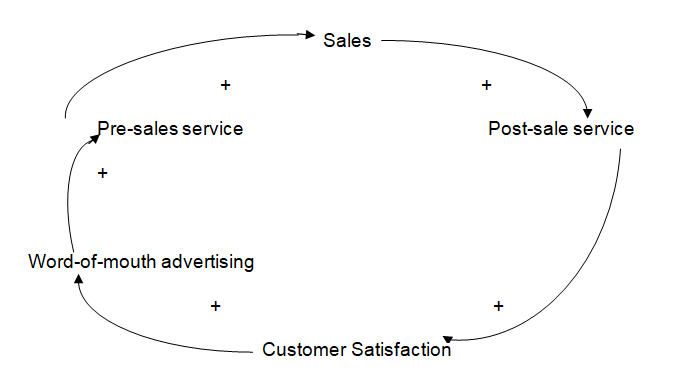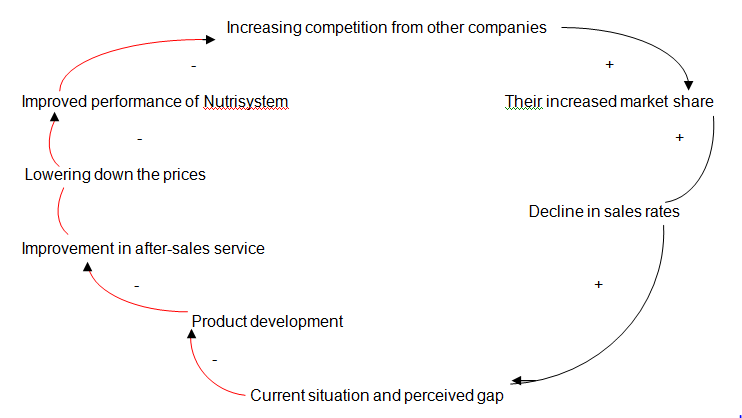Balancing and reinforcing feedback loops in Nutrisystem
Nutrisystem is a leading developer and retailer of weight loss products; moreover, this company provides programs and counseling to those people, who suffer from extra weight (Nutrisystem, 2011, unpaged).
Overall, this organization offers more than one hundred meal items to its customers, both male and female. This paper is aimed at apply such concept as feedback loop to this company.
Marketing strategies and customer relations
When speaking about marketing strategies of Nutrisystem and its relations with the customers, one can use reinforcing feedback loop. This tool is supposed to describe those activities which promote or amplify one another (Bellinger, 2004, unpaged).
Reinforcing feedback loops results either in exponential growth or decline of two variables (Larsen et al, 1996, unpaged). In the case of Nutrisystem, we need to discuss the interactions between such variables as customer satisfaction and marketing of the product, namely sales. Their interactions can be depicted with the help of this reinforcing feedback loop.

On the whole, it is possible to argue that customer satisfaction lies at the core of this feedback loop. It prompts clients to recommend the products of Nutrisystem to other people, who are concerned about their extra weight.
One should note that word of mouth recommendations are by far the most powerful form of advertising since a client is more likely to believe a person whom he/she knows because this individual is not paid to promote the product.
One can say that Nutrisystem pays much attention to word-of-mouth advertising; the website of this organization contains such section as “Success Stories” where people can read the customer’s reviews and their assessment of Nutrisystem’s products.
However, this reinforcing feedback loop is possible under several indispensible conditions, namely excellent pre and post-sale services.
In contrast, if they are not present, this reinforcing loop can be reversed, which means that dissatisfied customers will tell others that the products of Nutriystem are not worth buying and that they should consider different companies.
In the long term, such behavior can lead to dramatic decline in the revenues and inability to compete with other firms. Therefore, positive reinforcement should not be regarded as some permanent phenomenon that will exist irrespective of the company’s policies. Such a perception is entirely flawed and, mostly likely, dangerous because it can lead to a false sense of security.
Competition
In turn, balancing feedback loop depicts those variables which have to be brought into agreement or reconciled. In this case, the change in one variable is supposed to counteract or oppose the change in another variable (Larsen et al, 1996, unpaged).
The balancing feedback loop can be applied to the company’s attempts to gain competitive advantage over others or to strengthen its positions in the market. In this case, the major variables will be the intensity of competition and the financial performance of Nutrisystem. They can be depicted by means of this diagram.

This diagram shows how the company counterbalances the competition put up by the competitors. The red arrows indicate the corrective measures or actions which are aimed at gaining a larger market share and increasing sales.
It should be noted that this organizations operates in a very saturated market and there are many organization that offer similar products and services to the clients. Therefore, Nutrisystem has to use different methods to attract the clients.
For instance, this organization pursues a cost leadership strategy and lowers down the prices for its products. In fact, the weight control program offered Nutrisystem is believed to be the least expensive (Forbes, 2008, unpaged).
Apart from that, this organization always expands the variety of meal items they offer to the clients. Thus, one can say that the competition in the market can be represented as balancing feedback loop. Yet, this representation is valid only if the company possesses reliable and up-to-date information about the market, customers, and their competitors.
Theory of organizational learning
The theory of organizational learning is based on the premise that a company behaves not only a set of separate individuals or departments but as a system in which every component serves to achieve the common goal. Such an organization is also able to detect the opportunities or threats in internal and external environment and adjust to them.
Such adaptation is possible only if there are no barriers which impede the flow of information from business unit to another (Easterby-Smith & Lyles, 2005, p 21). A learning organization usually has such attributes as shared vision, systemic thinking, quick dissemination of knowledge, and team learning.
From behaviorist point of view, organizational learning can regarded as a reaction to a stimulus (external or internal factor), analysis of the information, dissemination of knowledge, and adaptation (Easterby-Smith & Lyles, 2005, p 219).
This adaptation is crucial for the successful performance of a company, its competitive strength, and its relations with the customer. Yet, one should bear in mind that organizational learning is possible only if it has tools for the analysis of information; without them the decision-making can hardly be effective.
In the previous section, some of these tools like feedback loops have been described. Additionally, it should be taken into consideration that the organization’s ability depends on several internal factors such as its culture and especially power distance between the employees.
For example, if the company has a complicated workplace hierarchy and bureaucratic structure, it might be less able to learn, since the flow of information in such a company is very slow. These are the major elements of organizational learning theory, and it can be quite applicable to Nutrisystem.
Opportunities for organizational learning
Overall, feedback loops can create excellent opportunities for organizational learning since they show the relations between different internal and external business processes. For instance, the reinforcing feedback loop depicts the relations between sales and customer satisfaction.
By using this tool, the management of Nutrisystem can understand what kind of actions must be taken to enhance customer loyalty. In this case, one can speak about the improvement of pre-sales and after-sales services.
Reinforcing loops indicate at those factors which affect the organization, such as customer satisfaction or word-of-mouth advertising. On their basis, the management can work out marketing policies, develop training programs for the personnel, or even change the product line.
The most important thing is to understand how the circle of reinforcement is created and what processes are involved in it. Additionally, by using these loops the management can understand how the circle of reinforcement can be broken or reversed.
Balancing feedback loops can be equally important for organizational learning. By applying these analytical tools, Nutrisystem can identify those forces which have an adverse effect on their performance, in particular, the intensity of competition in the market.
More importantly, balancing feedback loops help the management to mitigate the effects of these forces. The main strategies that we have identified are product development, improvement in services, and cost-leadership.
Balancing feedback loops can be helpful only in those cases, when the company can clearly identify the factors which shape the behavior of customers and understand the reasons why they can be choosing the products of different companies; otherwise the corrective measures will not be of any use.
The feedback processes shows where the company does well and which areas require improvement. It helps the management understand why a certain situation emerged and how it should be addressed if necessary. Only in this case, feedback loops can create valuable opportunities for organizational learning.
If the management wants to use feedback loops properly, they need to see the company as a system which has its boundary, structure, and components. Furthermore, they need to remember that to a certain extent every system is related to one another; the same thing can be said about sub-system of components.
Their task is to pinpoint the connections between these components. Another issue is that they need to view organizational learning as a continuous activity which cannot be limited only to a certain period of time.
Reference List
Bellinger, G. (2004) Introduction to systems thinking. Web.
Easterby-Smith. M & Lyles M. (2005). The Blackwell handbook of organizational learning and knowledge management. NY: Wiley-Blackwell.
Forbes.com. (2008). “How Expensive Is Your Diet?” Web.
Larsen, K., McInerney, C., Nyquist, C., Santos, A., & Silsbee, D. (1996) Learning Organizations (Part VI: Systems Thinking). Web.
Nutrisystem. (2011). The official website. Web.